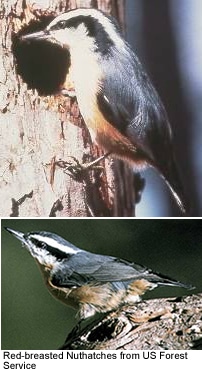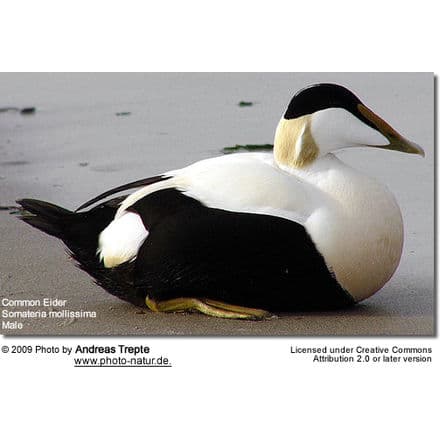Red-breasted Nuthatches
Information provided by: Avian Contributor: Jeannine Miesle
Distribution
While most of the subspecies of Nuthatch are year-round residents in their territories, the Red-breasted Nuthatches (Sitta canadensis) is a migratory subspecies that winters across vast expanses of the mountainous northern parts of North America, where the climate is more temperate. In breeding season, it can be found in the northern parts of Canada.
It is known to be a vagrant in parts of Bermuda, Iceland and England.
The lowland species of Eurasian and Red-breasted Nuthatches live most of the year in the northern parts of their widespread ranges, but choose more southern, mountainous areas in which to breed.
Habitat
Although most other Nuthatch species return to their solitary or paired lifestyles after breeding season, the Red-breasted Nuthatch is often seen living with other birds in small flocks. A highly energetic bird, the Red-breasted seeks out food at neighborhood feeders. This tiny bird prefers the north woods and western mountains as it territories. These passerines share the tree canopies with chickadees, kinglets, and woodpeckers; however, they climb the tree trunks and branches in search of bark furrows which provide them with hidden insects.
Red-breasted Nuthatches are mainly birds of coniferous woods and mountains. Look for them among spruce, fir, pine, hemlock, larch, and western red cedar as well as around aspens and poplars. In northeastern North America you can also find them in forests of oak, hickory, maple, birch, and other deciduous trees.
This bird is easily recognizable from its nasal, yammering call, and it can be heard among the sounds of a foraging flock of chickadees and other birds. To locate it, search along trunks and branches of trees for a bird scooting up, down, and sideways over the bark, and look for the Red-breasted Nuthatch’s bold black-and-white face pattern.
Description
Red-breasted Nuthatches are petite birds, only 11 cm (4 in) long. Their upper parts are blue-gray, and their underparts have a reddish cast. This hue is paler in the females. They have distinctive head markings; there is a black cap and a black eye stripe running through the white face. This is the only North American Nuthatch with a stripe over the eye. The throat is white as well.
The grey bill is long, straight and pointed. A small, compact bird, the Red-breasted Nuthatch has a very short tail and almost no neck, a broad chest, and very broad, short wings.
Feeding
Placing feeders in your yard will bring in many Nuthatches. Large seeds, such as sunflower and peanuts, as well as suet and peanut butter will attract them. Provide them with coniferous trees for both seeds and shelter, and you will have Nuthatches for many years to come
Red-breasted Nuthatches move quickly over trunks and branches probing for food in crevices and under flakes of bark. They creep up, down, and sideways without regard for which way is up, and they don’t lean against their tails the way woodpeckers do. Flight is short and bouncy.
Breeding
Most Nuthatches make use of natural holes or old woodpecker nests in which to build their nests, but the Red-breasted prefers to excavate its own tree-hole nests.
Like some other Nuthatches, this bird uses mud to seal up the cracks reduce the size of the entrance hole. Clever birds, they secure the nest by daubing sticky conifer resin globules around the entrance; the male applies the resin to the outside and the female applies it to the inside. This resin has the advantage of deterring predators from entering the nest.
The breeding pair is careful not get the sticky substance on themselves; they fly directly through the entrance hole into the nest.
Red-Breasted Nuthatch Incubation / Fledging Times
Vocalizations
The Red-breasted Nuthatch co-exists with the Black-capped Chickadee throughout much of its range, and it is able to understand the Chickadee’s calls. The Chickadee varies its calls, thus communicating information about the size and threat posed by potential predators. Many birds recognize the simple alarm calls produced by other species, but the Red-breasted Nuthatch is able to interpret the chickadee’s detailed variations and to respond appropriately.
It is said to have a call which sounds like a tin trumpet.
Please Note: The articles or images on this page are the sole property of the authors or photographers. Please contact them directly with respect to any copyright or licensing questions. Thank you.




